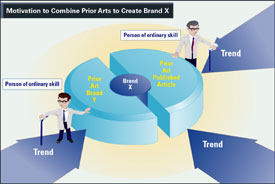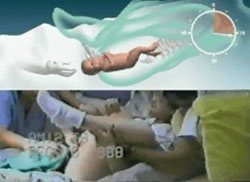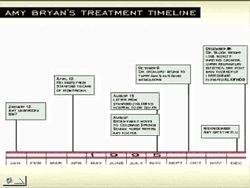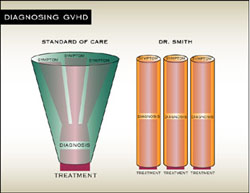Animators has extensive experience working on cases dealing with highly technical scientific principles, such as those involving pharmaceutical drugs, biotechnology and medical malpractice. For many of the same reasons as patent litigation, cases in these areas often involve issues that translate easily into the use of animation and are usually extremely difficult for a judge or jury to understand.
Pharmaceutical
Animators has worked on a variety of cases involving such major pharmaceuticals as: Cyproflaxin, Tylenol, Aleve, Bayer Aspirin, and Fen-Phen. Animated pharmaceutical trial exhibits have been frequently created in PowerPoint.

In one recent example involving a leading pharmaceutical manufacturer, Animators created numerous dynamic trial exhibits on behalf of a competitor, which was seeking to invalidate the manufacturer's patent in order to market a more affordable generic version. In that case, Animators was tasked with graphically demonstrating that the manufacturer should not have been issued a patent on its product. We have created pharmaceutical trial exhibits for both brand and generic pharma firms.
Although the case involved significant patent law issues relating to the "obviousness" of the product at issue, it was critical that the fact finder also comprehend the complex make-up of the product as well as its effects on the human body. Animators created a series of carefully crafted trial exhibits which helped show that the product was simply the result of combinations which were well known in the art at the time of its creation. As a result, Animators' was able to transform this complex case involving both patent law and medical issues into an easy to understand presentation for the fact finder.
human body. Animators created a series of carefully crafted trial exhibits which helped show that the product was simply the result of combinations which were well known in the art at the time of its creation. As a result, Animators' was able to transform this complex case involving both patent law and medical issues into an easy to understand presentation for the fact finder.
Medical Malpractice
Animators is routinely called upon to create powerful and dynamic demonstratives in medical malpractice cases in order to give juries unprecedented access to medical information and procedures. For example, the use of animation in medical malpractice cases has allowed juries to observe complicated medical procedures as if they were in the delivery or operating room.
In one compelling example of how animation can be used in conjunction with actual video footage, in order to give the jury a “view” that they could not otherwise have,  Animators juxtaposed actual video of a childbirth taken from inside the delivery room with an animation of what was occurring inside the mother. This allowed the jury to view actual video of what the doctor was doing, while simultaneously viewing animation depicting what was happening to the baby as a direct result of the doctor’s actions. Once again, the use of this powerful demonstrative allowed the jury to view events that they otherwise normally could not.
Animators juxtaposed actual video of a childbirth taken from inside the delivery room with an animation of what was occurring inside the mother. This allowed the jury to view actual video of what the doctor was doing, while simultaneously viewing animation depicting what was happening to the baby as a direct result of the doctor’s actions. Once again, the use of this powerful demonstrative allowed the jury to view events that they otherwise normally could not.
In another extremely complicated wrongful death case involving recurring instances of medical malpractice over a lengthy time span, Animators combined both interactive electronic exhibits along with printed trial boards in order to aid the jury in understanding the complicated medical concepts at issue.
One of the most significant examples involved an electronic timeline that was projected onto a 10 ft. x 10 ft. screen. This electronic interactive exhibit  included photographs and documents embedded in the timeline so that the attorneys could allow the jury to observe exactly what had occurred on a particular day. For example, the attorneys were able to select a particular date and allow the jury to observe the condition of the deceased on that date. The attorneys were also able to select other relevant dates and instantly call up relevant medical records. By organizing these critical documents and photographs in a timeline that could be easily accessed, Animators allowed the jury to view the deterioration of the deceased’s condition and to identify the precise points of malpractice.
included photographs and documents embedded in the timeline so that the attorneys could allow the jury to observe exactly what had occurred on a particular day. For example, the attorneys were able to select a particular date and allow the jury to observe the condition of the deceased on that date. The attorneys were also able to select other relevant dates and instantly call up relevant medical records. By organizing these critical documents and photographs in a timeline that could be easily accessed, Animators allowed the jury to view the deterioration of the deceased’s condition and to identify the precise points of malpractice.
Moreover, through the use of an interactive exhibit, the attorneys were able to alter their presentation “on the fly” as necessary. This is particularly helpful in trial situations where unexpected issues or testimony arise which must be quickly explained or dispelled.
In another noteworthy case, Animators was called up to illustrate a doctor’s failure to diagnose a bone-marrow transplant rejection.
The patient presented with nine  separate symptoms that, had the doctor attempted to find a unifying diagnosis as was required under Colorado law, the patient’s death could have been avoided. Instead, the doctor treated each symptom individually rather than connecting the symptoms to the underlying issue.
separate symptoms that, had the doctor attempted to find a unifying diagnosis as was required under Colorado law, the patient’s death could have been avoided. Instead, the doctor treated each symptom individually rather than connecting the symptoms to the underlying issue.
Animators’ experience in the medical industry has also included helping to convey information about complex medical devices, as well as explaining the microbiological development of cancer.
"We made the right decision when we hired you. You are absolutely the best."
Holland & Knight"I am very happy with the quality of A2L's work and happy with the graphics. One of the best jury consultants I have worked with."
Gibson Dunn & Crutcher"If you are in need of highly qualified, creative, diligent and personable providers of trial graphics, I recommend A2L. They were wonderfully helpful and supportive of our team and demonstrated, repeatedly, real skill in creating graphic and demonstrative exhibits that captured the essence of our presentation. Just as important, they did this under extreme time and quality pressure and, always, with a smile."
Foley & Lardner"Your team did a very nice job on the simulation in the engine case and I will certainly keep and your team in mind for future litigation support needs."
Finnegan"You guys were great, I’ll definitely use you again."
Fidelity National Law GroupPersuadius (formerly A2L Consulting) has extensive experience in complex litigation. For over twenty-five years, we have worked with all top law firms on more than 10,000 matters with at least $2 trillion cumulatively at stake. Persuadius (as A2L) is regularly voted best jury consultants, best trial consultants, and best litigation graphics consultants.
© Persuadius 1995-2026, All Rights Reserved.
Nationwide Contact: 1-800-847-9330